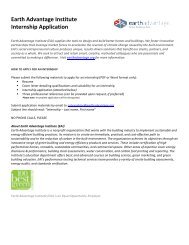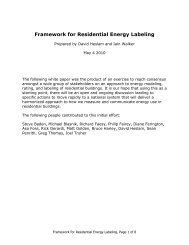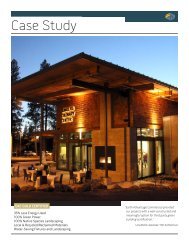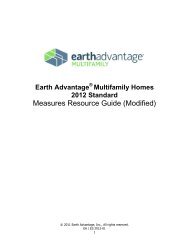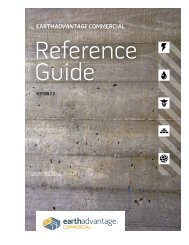EA New Homes Measures Guide - Earth Advantage
EA New Homes Measures Guide - Earth Advantage
EA New Homes Measures Guide - Earth Advantage
Create successful ePaper yourself
Turn your PDF publications into a flip-book with our unique Google optimized e-Paper software.
2012 <strong>Earth</strong> <strong>Advantage</strong> Residential<br />
<strong>Measures</strong> Resource <strong>Guide</strong><br />
3.6.2<br />
Accountability Form: General Energy Health Land Materials Water<br />
Durable Roof<br />
0 0 1 1 0<br />
Description: Install a durable roof, such as clay tile, concrete tile, slate, metal, or composition shingles with a lifetime warranty.<br />
Benefit: Installing longer-lasting materials is better for the environment than cheaper, less-durable products. Durable materials are<br />
environmentally preferable for several reasons. First, durable materials limit the demand for scarce resources and the pressure on local<br />
landfills for disposal of used products. Durable shingles will be replaced less often than the typical product with a 20-year warranty.<br />
Second, because they must be replaced less often, durable materials avoid the embodied energy costs incurred by the replacement of the<br />
shorter lived products. Finally, durable materials are a better investment in the long run because they tend to require less maintenance<br />
and fewer repairs. Composition shingles are made using asphalt, a petroleum-based product. This requires significant energy resources to<br />
manufacture and generates VOC's when installed. VOC's pose a health risk to construction personnel and contribute to ground level ozone,<br />
a major component of smog. By using the most durable products available, these impacts can be reduced. All other things being equal, the<br />
more durable the product, the better its overall resource efficiency.<br />
Verification: The builder will complete the Accountability Form, attesting to the 40-year or longer warranty of the product or documentation<br />
demonstrating comparable performance, and forward it to the <strong>EA</strong> rater.<br />
3.6.3<br />
Accountability Form: General<br />
Recycled Content: Metal or composition (50% recycled content)<br />
Energy<br />
Materials<br />
Water<br />
0 0 0 1 0<br />
Description: Install roofing material that contains at least 50 percent recycled content. This can be post industrial, post consumer, or a mix<br />
of the two. Metal roofing comes in several forms, including standing seam and shingles. Composite roofing can also contain recycled<br />
content in the form of mineral aggregate. Several companies make recycled plastic roofing. This is generally a mix of wood waste and<br />
recycled plastic or rubber. These composite materials are relatively new in the market, so the actual durability is unknown.<br />
Health<br />
Land<br />
Benefit: Roofing material has a large life cycle impact, because it must be replaced many times over the life of a house. Using recycled<br />
content material reduces the raw materials and processing energy required to make replacement material. The main benefit of metal<br />
roofing is durability. Most steel contains recycled content, generally assumed to be about 60 percent industry-wide. Metal roofing has a<br />
well-established system for collecting and recycling steel. It also lasts longer, which means less embodied energy for each year of service.<br />
Metal roofing is a good investment in the long run because it tends to require less maintenance and fewer repairs. Some roofing products<br />
come with high-quality finishes that protect them from moisture and ultraviolet degradation. Composite roofing that contains recycled<br />
material also reduces industrial waste. However, composites are unlikely to be recyclable themselves when it is time to replace them.<br />
Verification: <strong>EA</strong> Rater can easily identify standing seam metal roofing. The builder or responsible party will complete the Accountability<br />
Form for recycled content shingles and forward it to the <strong>EA</strong> Rater.<br />
3.7 Exterior<br />
3.7.1<br />
Fiber Cement Siding: (50-100%)<br />
Energy<br />
Materials<br />
Water<br />
0 0 0 1 0<br />
Description: Install fiber-cement siding as either lap siding or panels. It is strongly advised that clippers or pneumatic shears are used to<br />
cut the siding during installation instead of circular saws. Fiber cement siding releases silica dust when it is sawn. Silica dust is extremely<br />
fine and can lead to respiratory problems if inhaled.<br />
Health<br />
Land<br />
Benefit: Fiber cement siding is made with Portland cement, sand, clay, and wood fiber. It is very durable and requires less painting and<br />
repairs. However, the embodied energy is high because of the large quantity of Portland cement.<br />
Verification: <strong>EA</strong> Rater will verify that fiber cement siding is installed on at least 50% of the house.<br />
Page 21 of 70



